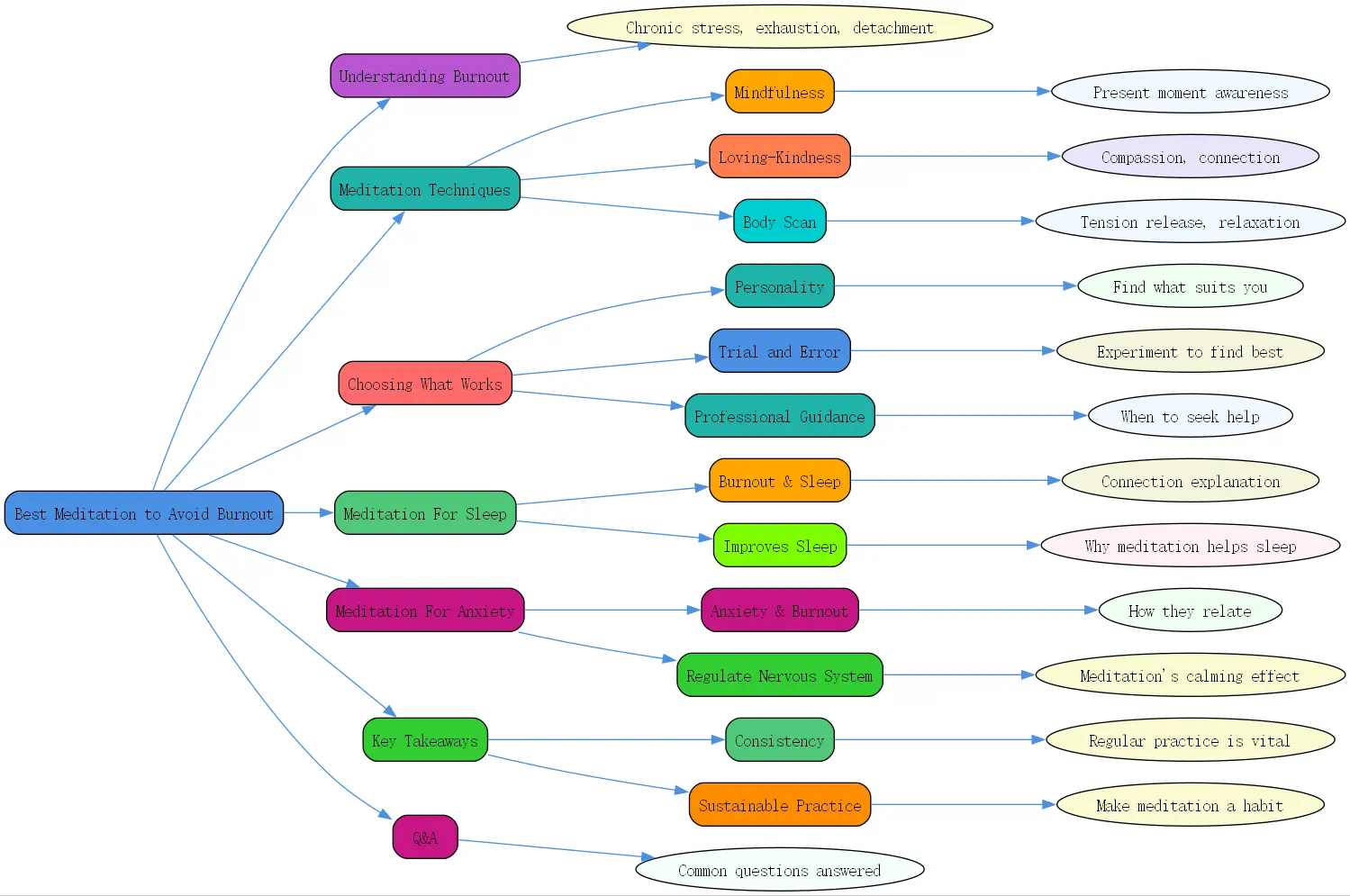Understanding Burnout and Its Impact

Burnout has become increasingly prevalent in our fast-paced, high-pressure society. This state of chronic stress manifests through physical and emotional exhaustion, cynicism, detachment, and a reduced sense of personal accomplishment. The causes often stem from prolonged workplace stress, overwhelming responsibilities, and an inability to disconnect from our commitments.
The physical symptoms of burnout can include persistent fatigue, insomnia, and weakened immunity, while psychological indicators might involve feelings of helplessness, detachment, and loss of motivation. Left unaddressed, burnout can lead to serious health consequences including depression, anxiety disorders, and cardiovascular problems.
Meditation offers a powerful antidote to the burnout epidemic. By activating the parasympathetic nervous system—our body’s natural relaxation response—meditation helps counteract the stress hormones that fuel burnout. Regular practice creates a buffer against daily stressors and helps build emotional resilience that prevents burnout from taking hold.
Meditation Techniques for Burnout Prevention
Mindfulness Meditation: Cultivating Present Moment Awareness
Mindfulness meditation is widely regarded as one of the best types of meditation to avoid burnout due to its focus on present-moment awareness without judgment. This practice involves paying deliberate attention to your thoughts, feelings, and sensations as they arise, observing them without criticism.
How to practice mindfulness meditation:
1. Find a quiet, comfortable place to sit with your back straight. 2. Set a timer for 5-10 minutes (gradually increase as you become more comfortable). 3. Close your eyes or maintain a soft gaze downward. 4. Focus your attention on your breath—the sensation of air flowing in and out. 5. When your mind wanders (which it naturally will), gently redirect attention back to your breath. 6. Continue this process, bringing awareness to the present moment each time you notice yourself getting caught in thoughts.
Benefits of mindfulness meditation for burnout:
Mindfulness meditation helps reduce the rumination and worry that often contribute to burnout. Research has shown that regular practice increases gray matter in brain regions associated with emotional regulation and stress response. For those experiencing burnout symptoms, mindfulness offers a way to disengage from automatic negative thought patterns and create mental space between stressors and your reactions to them.
Loving-Kindness Meditation (Metta): Fostering Compassion and Connection
Loving-kindness meditation, also known as Metta, specifically targets the emotional depletion and cynicism that characterize burnout. This practice focuses on cultivating feelings of goodwill, kindness, and compassion toward yourself and others.
How to practice loving-kindness meditation:
1. Sit comfortably with eyes closed, taking a few deep breaths to center yourself. 2. Begin by directing positive wishes toward yourself with phrases like: “”May I be happy. May I be healthy. May I be safe. May I live with ease.”” 3. Repeat these phrases slowly, allowing feelings of warmth and goodwill to arise. 4. Gradually extend these wishes to others—first to someone you care about, then to a neutral person, then to someone challenging, and finally to all beings. 5. Practice for 10-15 minutes, focusing on the sensations of warmth and openness in your heart.
Benefits of loving-kindness meditation for burnout:
Loving-kindness meditation directly addresses the emotional exhaustion and interpersonal difficulties associated with burnout. Regular practice has been shown to increase positive emotions, reduce negative emotions, and improve relationship satisfaction. For professionals experiencing compassion fatigue—a common aspect of burnout—this meditation rebuilds emotional reserves and fosters a sense of connection that counters detachment.
Body Scan Meditation: Releasing Tension and Promoting Relaxation
The body scan is particularly effective for burnout as it addresses the physical manifestations of chronic stress that accumulate in the body. This practice involves systematically bringing attention to different parts of the body, noticing sensations without trying to change them.
How to practice body scan meditation:
1. Lie down in a comfortable position or sit with your back supported. 2. Close your eyes and bring awareness to your breath for a few moments. 3. Begin by focusing attention on your toes, noticing any sensations present. 4. Slowly move your attention upward—feet, ankles, calves, knees, and so on—all the way to the top of your head. 5. At each area, pause to notice sensations: tension, temperature, tingling, or perhaps no sensation at all. 6. If you notice tension, breathe into that area and imagine the tension dissolving with each exhale. 7. Complete the practice by bringing awareness to your body as a whole.
Benefits of body scan meditation for burnout:
Body scan meditation helps reconnect you with physical sensations often ignored during burnout states. By bringing conscious awareness to the body, you can identify stress-related tension before it escalates and take proactive steps to release it. The practice promotes somatic awareness—the ability to recognize how stress manifests physically—which is crucial for early intervention in the burnout cycle. Many practitioners of managing anxiety meditation find that body scan techniques are particularly helpful for addressing physical symptoms of stress.
Choosing the Best Type of Meditation for Your Needs

Considering Your Personality and Preferences
The most effective meditation practice for preventing burnout is one that resonates with your personal preferences and temperament. If you’re analytical by nature, a breath-focused mindfulness practice might appeal to your systematic tendencies. Those who are emotionally oriented might find loving-kindness meditation more engaging and beneficial.
Consider your schedule and lifestyle as well. If you’re already experiencing burnout symptoms, starting with shorter sessions (5-10 minutes) is more sustainable than attempting longer practices that might feel overwhelming. The goal is consistency rather than duration, especially when beginning.
Trying Different Techniques: A Trial-and-Error Approach
There’s no one-size-fits-all when it comes to the best type of meditation to avoid burnout. Experiment with various techniques to discover what resonates most deeply with you. You might find that different practices serve different needs—perhaps body scan works best before bed, while mindfulness helps during lunch breaks at work.
Keep a simple meditation journal noting which practices feel most restorative. Track your energy levels, sleep quality, and stress response before and after different meditation sessions. This personal data helps identify which techniques offer the most benefit for your specific burnout symptoms.
When to Seek Professional Guidance
While meditation is powerful for preventing and addressing burnout, sometimes professional guidance is necessary. Consider working with a meditation teacher if you:
- Find it difficult to establish a consistent practice
- Experience increased anxiety during meditation
- Need personalized adaptations to standard techniques
- Want to deepen your practice beyond basic instructions
For those experiencing severe burnout symptoms like persistent depression or anxiety, meditation works best as part of a comprehensive approach that may include therapy, medical care, and lifestyle modifications. BrainTalking experts recommend combining meditation with professional support for optimal results.
The Best Type of Meditation For Sleep
The Connection Between Burnout and Sleep
Sleep disturbances and burnout create a destructive cycle—burnout disrupts sleep, and poor sleep exacerbates burnout symptoms. Breaking this cycle is essential for recovery. The best type of meditation for sleep addresses both the physical tension and mental rumination that prevent restful sleep.
Body scan meditation is particularly effective before bedtime as it promotes physical relaxation. Another powerful technique is guided imagery meditation, where you visualize peaceful scenes while focusing on sensory details. This redirects the mind from stress-inducing thoughts toward calming imagery that prepares the brain for sleep.
Why Meditating Improves Sleep Quality
Meditation activates the parasympathetic nervous system, decreasing alertness and promoting relaxation. Regular practice reduces the hyperarousal that often prevents sleep in those experiencing burnout. Studies show meditation can increase melatonin production (the sleep hormone), decrease the time it takes to fall asleep, and improve overall sleep quality.
For optimal results, establish a consistent pre-sleep meditation routine of 10-15 minutes. The regularity signals to your body that it’s time to transition to rest, creating a powerful sleep cue that works with your natural circadian rhythms.
The Best Type of Meditation for Anxiety
How Anxiety Contributes to Burnout
Anxiety and burnout are deeply intertwined, with anxiety often preceding and intensifying burnout symptoms. The constant activation of the fight-or-flight response that characterizes anxiety depletes the physical and emotional resources needed to cope with daily stressors, accelerating the path to burnout.
The best type of meditation for anxiety focuses on grounding techniques that interrupt the anxiety cycle. Breath-focused practices are particularly effective as they provide a tangible anchor for attention when anxious thoughts arise. The 4-7-8 breathing technique (inhale for 4 counts, hold for 7, exhale for 8) activates the parasympathetic nervous system, directly countering anxiety’s physiological effects.
Using Meditation to Regulate the Nervous System
Meditation builds nervous system regulation skills through consistent practice. By repeatedly bringing yourself back to a present-moment focus during meditation, you strengthen the brain’s ability to disengage from anxious rumination. This skill transfers to daily life, helping you recognize and interrupt anxiety spirals before they escalate.
Structured practices like managing anxiety meditation teach your nervous system to shift from sympathetic (fight-or-flight) to parasympathetic (rest-and-digest) activation at will. This ability to self-regulate provides a powerful buffer against the anxiety that fuels burnout.
What is the Best Type of Meditation? Key Takeaways
Consistency is Key
The best type of meditation to avoid burnout is ultimately the one you’ll practice consistently. Research consistently shows that frequency matters more than duration when it comes to meditation’s benefits. A daily five-minute practice yields more positive outcomes than occasional hour-long sessions.
Start with a commitment that feels achievable—perhaps just two minutes daily—and gradually increase as the habit becomes established. Use habit-stacking by attaching meditation to existing routines (like morning coffee or brushing teeth) to increase consistency.
Creating a Sustainable Meditation Practice

To create a sustainable practice that effectively prevents burnout:
- Designate a specific meditation space that’s comfortable and minimally distracting
- Use guided meditations (apps, recordings) when beginning to provide structure
- Set realistic expectations—the goal isn’t to stop thinking but to change your relationship with thoughts
- Track your progress using metrics beyond time spent meditating (energy levels, stress resilience, sleep quality)
- Join a meditation group or find an accountability partner to maintain motivation
- Practice self-compassion when you miss sessions rather than abandoning the practice altogether

Remember that meditation is not just an activity but a skill that develops over time. The benefits accumulate gradually through consistent practice, creating resilience against burnout before it takes hold.
Q&A: Common Questions About Meditation for Burnout
Q: How long should I meditate to prevent burnout?
A: Research suggests that even 5-10 minutes of daily meditation can produce meaningful benefits for stress reduction. The key factor is consistency rather than duration. Begin with a timeframe that feels sustainable given your current energy levels and gradually increase as the practice becomes habitual. For burnout prevention, many experts recommend working up to 15-20 minutes daily, but even shorter regular sessions are beneficial.
Q: Can meditation alone cure existing burnout?
A: While meditation is a powerful tool for managing and preventing burnout, severe burnout typically requires a multi-faceted approach. Meditation works best as part of a comprehensive strategy that may include professional support, boundary-setting, adequate rest, physical activity, and potentially temporary modifications to work responsibilities. Think of meditation as an essential component rather than a standalone solution for established burnout.




